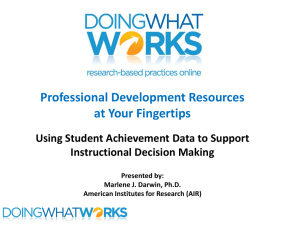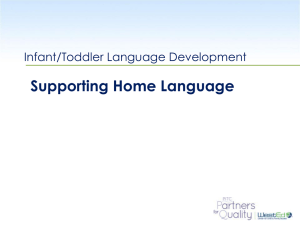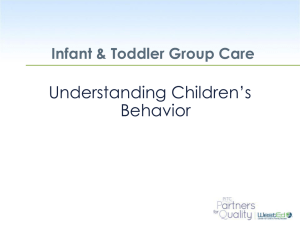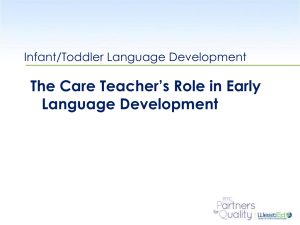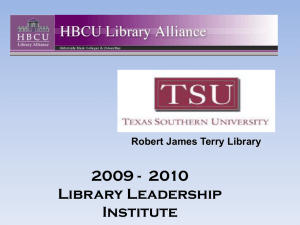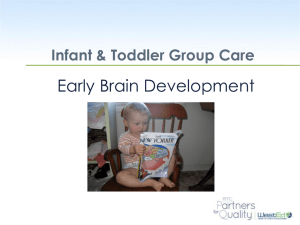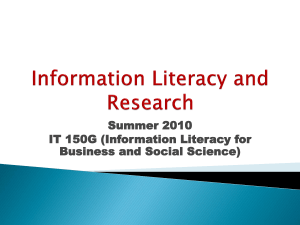English - The Program for Infant/Toddler Care
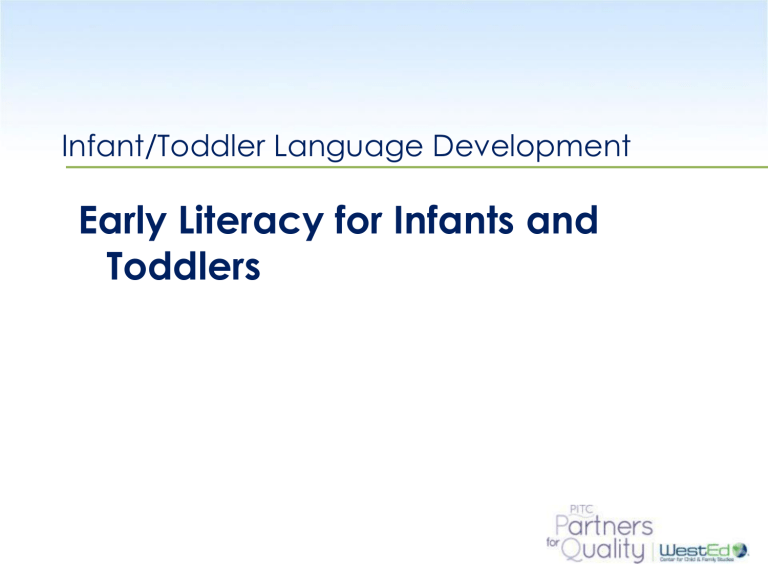
Infant/Toddler Language Development
Early Literacy for Infants and
Toddlers
WestEd.org
Discussion Activity (Dyads)
• Find a partner and discuss changes you made to support infant/toddler language development.
• What did you learn about yourself from doing this assignment?
WestEd.org
“The foundation of literacy is established in the early years through a variety of two-way exchanges with others, such as pretend play, imitation, songs, and experiences with books and stories.”
California Department of Education (2006) Infant/Toddler Learning and
Development Guidelines, pg. 96
WestEd.org
Learning Objectives
• Discuss how language and literacy develop simultaneously and are interrelated.
• Demonstrate ways to nurture and support the developmental process of early language and literacy.
WestEd.org
Stories and Early Literacy
Stories are a central part of young children’s learning and their development of early language and literacy.
(Im et al., 2004, p. 23)
WestEd.org
Stories and Early Literacy
Cognitively, young children use “storying” to process, understand, and reflect on their experiences.
WestEd.org
Stories and Early Literacy
• Stories can be shared in a variety of ways. Adults can share stories through language, but infants and toddlers share their stories too – with a flick of their eyes, the point of a finger, or a coo.
• Recognizing and responding to the stories that babies and toddlers share reinforces their will to communicate and their sense of themselves as powerful storytellers.
( The Powerful Role of Stories in Supporting Language and Literacy, by
Rebecca Parlakian, Carol Osborn, and Janice Im)
WestEd.org
Jigsaw Activity
• Read the assigned section of the article
“Using Stories Effectively with Infants and
Toddlers”.
• Write the key points from your assigned section on chart paper.
WestEd.org
Dyad Activity
1. Find a partner .
2. Plan to share a “pocket story” that you “carry with you.”
3. A “pocket story” is a short story about a personal item that you currently have with you or on you
(article of clothing, jewelry, an item in your wallet or purse).
4. Share this pocket story with your partner.
( Zero to Three Cradling Literacy Module 1: Session 1: The Powerful Role of Stories in Supporting Early Language and Literacy)
WestEd.org
BREAK
WestEd.org
Infant/Toddler Interest in Print
• Infants show an interest in print at first through physically exploring, such as by putting books in their mouths, handling books, or focusing on print in the environment.
• Because early experiences with print contribute to later literacy, shared book reading is recommended as a valuable way to promote emergent literacy.
(Whitehurst and Lonigan, 1998).
California Infant/Toddler Learning & Development Foundations
WestEd.org
Interest in Print at 8 months
At around eight months of age, children explore books and show interest in adultinitiated literacy activities, such as looking at photos and exploring books together with an adult.
WestEd.org
Interest in Print at 18 months
• At around 18 months of age, children listen to the adult and participate while being read to, by pointing, turning pages, or making one- or two-word comments.
• Children actively notice print in the environment.
WestEd.org
Interest in Print at 36 months
At around 36 months of age, children show appreciation for books and initiate literacy activities: listening, asking questions, or making comments while being read to; looking at books on their own; or making scribble marks on paper and pretending to read what is written.
WestEd.org
Reflection
• Think of three children in your care and answer the questions for Reading in
Group Care Settings.
• Each person will answer questions for their group of children (these could be the children in your primary care group).
WestEd.org
Dyad Activity
• Find a partner, and share information about the three children in your care.
• After sharing information about the children, discuss the following:
Did you come up with some new ideas for supporting each child’s interests in books?
Did you get some new ideas from your partner?
WestEd.org
Relating Stories to Children’s Interests
Imagine that you are a caregiver for a group of two-year-olds. Several of the children have become interested in taking off and trying to put on their shoes, which they do several times each day for several days.
WestEd.org
Reflect on how you can build on this interest through stories/or storybook reading.
Answer the following questions:
• How will you share stories related to this new interest?
What other experiences will you plan to provide?
• If you are not familiar with books related to this interest, where will you turn for suggestions?
• Can you alter the words of a well-known rhyme or song so that it fits with the children’s interest in shoes?
• How will you share this information about the children’s interest with families?
(Adapted from : “From Lullabies to Literature: Stories in the Lives of Infants and
Toddlers by Jennifer Birckmayer, Anne Kennedy, and Anne Stonehouse)
WestEd.org
Quilting Our Stories
• Recall a favorite family or children’s story from your childhood and think about why it’s important to you.
• Illustrate or write your story on an index card.
• When you are done illustrating/writing your story, share your story with a partner.
WestEd.org
Summary
• Right from birth, young infants come with, and begin learning, the skills needed for language and literacy.
• Early literacy is what young children know about reading and writing before they can actually read and write (e.g., how to hold a book or crayon/pencil; different sounds make up different words and communicate messages; symbols convey meaning.)
(Zero to Three: Cradling Literacy)
WestEd.org
